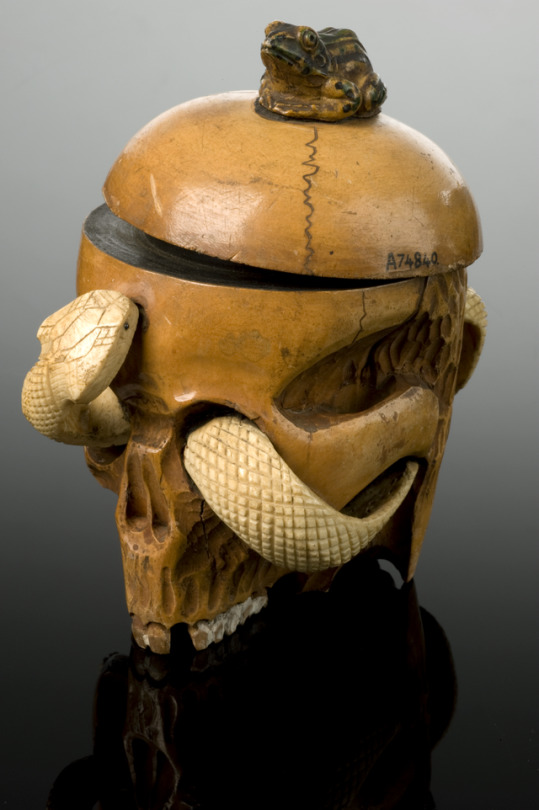Who are people? How did we develop? Where do we come from? What is our past and how does it relate to us? Archaeology, Anthropology, History, Geography, and a little Philosophy. I love learning about these things and I love to share all the things I learn. Feel free to ask me anything and open up discussions that can help educate myself and others more.
Don't wanna be here? Send us removal request.
Text
Japanese Tobacco Box, circa 18th Century

What makes this box particularly ironic is that at the time, no one knew tobacco’s connection with cancer and ill-health. It was just an interesting box that happened to be for holding tobacco!
1K notes
·
View notes
Photo

Fresco of a fisherman from the Minoan period, ca. 1600 BCE, in Akrotiri, Santorini, Greece. The settlement at Akrotiri was a major spot for sea travel and trade, as it was in between Cyprus and Crete, the core of Minoan culture. A volcanic eruption destroyed much of the island in the 1500s BCE; the climate change resulting from the eruption is suspected to have begun the decline of Minoan civilization.
186 notes
·
View notes
Photo




Merry Xmas Everyone!
Today it’s not uncommon for people to abbreviate the word “Christmas” into Xmas, something I am certainly guilty of when I mail out dozens of Xmas cards out to my friends and family. Some others are irked by this abbreviation, claiming that it’s part of some plot by secularists to take Christ out of Christmas. In 2009 Rev. Franklin Graham, son of televangelist Billy Graham stated,
“for us as Christians, this is one of the most holy of the holidays, the birth of our savior Jesus Christ. And for people to take Christ out of Christmas. They’re happy to say merry Xmas. Let’s just take Jesus out. And really, I think, a war against the name of Jesus Christ.”
This brings up a good question, how did X become an abbreviation for Christ? What is the truth of the matter?
In the earliest days of Christianity Greek was a common language in the Roman Empire, and many of the first Christians had a Hellenic or Hellenistic heritage. In the Greek alphabet Christ was spelled “Χριστος” which many Christians shortened to merely “X” or “XP”. Since Christianity was frowned upon in the Roman Empire at best, and actively persecuted at worst, both symbols became a secret code used by Christians to identify each other, much like the popular “Jesus Fish”. Eventually “XP” was merged into one symbol called the Chi Rho, which also became popular.

In 312 AD Roman Co-Emperor Constantine was fighting a civil war against his rival, Co-Emperor Maxentius for control of the Roman Empire. On October 27th, the armies of Constantine and Maxentius faced off at the Milvian Bridge for a final showdown. On the night before the battle, Constantine received a vision from God telling him to have his soldiers paints a Heavenly divine symbol on their shields. That symbol was the Chi Rho. Or maybe not, it could have been a similar symbol called a staurogram, the sources don’t agree. Anyway, Constantine’s army won the battle the next day, Constantine legalized Christianity in the Roman Empire with Constantine becoming the first Christian Roman Emperor. Or so the story goes, historical evidence suggests Constantine made the whole “heavenly symbol” thing up after the fact for propaganda purposes.
Regardless, the Chi Rho or became an official symbol of the Roman Empire and the later Eastern Roman (Byzantine) Empire. Today it is still used by the Roman Catholic Church, the Orthodox Chruch, and many Protestant denominations. Use of the Chi Rho as an abbreviation for Christ continued throughout the Middle Ages. Then in the 16th century English scribes and writers began to use X as an abbreviation not only for Christ, but for anything with Christ in it. Christmas became Xmas, Christians became Xtians, even names like Christopher and Christine became Xtopher and Xtine. Hence why Christina Aguilera sometimes goes by the names Xtina. The use of the word Xmas especially became popular during the 18th and 19th century as a way for rich nerds to show off how they know their Greek. At the time cool people studied classical Greek. Today the tradition continues, a tradition which comes in handy when you have dozens Xmas cards to mail out.
967 notes
·
View notes
Text
Things that have killed an English Monarch
Unknown
Murder
Tummy troubles
Unknown
Unknown
Murder
We're not sure
Unknown
Same dude as We're not sure
Assassinated on the toilet
Jaundice
It's a mystery
Too much alcohol
Banishment and strokes
Arrow to the eyeball
A saddle
Old age
Too many lamprey eels
That bitch John
Accidental crossbow bolt
Dysentery
Old age again
Dysentery again
Untimely mystery
Stroke
Starved by bullies
Some nasty disease
Dysentery again again
Murder most foul
General ill health
Murder (not by Richard III I'll fight you on that)
Died on the battlefield
Tuberculosis
So so so many health problems
Fatal illness
Cancer
Old age
Dysentery again again again
Beheaded
Kidney problems
Brain hemorrhage
Smallpox
Pneumonia
Stroke again
Stroke again again
Thoracic aortic dissection
Dementia
Obesity related conditions
Old age
Old age
Heart attack
Morphine and cocaine injections
Laryngeal cancer
Lung cancer
SHE'S STILL KICKIN FOLKS
2K notes
·
View notes
Photo

This is my sweet baby chuncky monkey. Who knew you could love something so small so much ❤❤❤💕 #breastfeedingmom #breastfeeding #babyboy #3monthsold #EzekielThomasHendricks #littlelove https://www.instagram.com/p/B5jTlHHgpxn/?igshid=17whrekj3clac
1 note
·
View note
Photo

“Pope St. Leo the Great died on Nov. 10, 461. He was proclaimed a Doctor of the Church by Pope Benedict XIV in 1754. A large collection of his writings and sermons survives, and can be read in translation today.”
Source: http://www.catholicnewsagency.com/saint.php?n=651
#history#pope#catholic history#catholic#catholiscism#pope leo the great#november#november 10th#461#pope benedict xvi#pope benedict xiv#st. leo the great#post of the day#today in history#history today
3 notes
·
View notes
Photo

62 years ago today Benjamin O. Davis, Jr. became the first African American general in the United States Air Force. He retired in 1970 as lieutenant general. He published an autobiography in 1991 titled “Benjamin O. Davis, Jr., American: An Autobiography”
3 notes
·
View notes
Text
Needed reminders. Knowledge is the best path to take.
10 Things I Tell Myself When I Don’t Want To Study
1. You are very lucky and privileged to have access to almost unlimited knowledge and you should appreciate that.
2. Be one of those rare people who step over their insecurities and succeed.
3. You will know what to do as soon as you start. Ideas never appear from inactivity.
4. Make yourself proud.
5. It’s not supposed to be easy. Nothing good ever is.
6. One hour every day doesn’t feel much but its 365 hours a year. You can’t not succeed after so much work.
7. If you give up now, you’ll have to return to this later anyway but from the very beginning.
8. Maybe you think you can never find something to use your skills and mindset for. But if you continue investing in what matters to you, it will find its way out there.
9. Every moment you thought your fears would suppress you has become the time you made it.
10. Make yourself proud.
12K notes
·
View notes
Note
It is so common for things to get removed and thrown away seasonally in US cemeteries. Most of the cemeteries I've gone to even have big trashcans filled with flowers and wreaths and stuff people have put out. I rubs me the wrong way sometimes, but it is really typical. And yeah, having a bulldozer in an active cemetery is pretty par for the course.
we have entire areas meant for trash, too, but I have never seen anyone else throwing things out that the people taking care of their own loved ones’ graves - unless it was a lot of broken glass after storm, or trash people left on the paths.
the way our cemetries look and are… “planned”… there is no way for any heavy machinery to get even close to a grave, unless the graveyard is brand new and just a field for now.
2K notes
·
View notes
Photo

Precinct of Amun-Re
The royal touring party that accompanied “Bertie” (Albert), Prince of Wales and future King Edward VII, to Egypt during 1861-62.
Photo: Francis Bedford
427 notes
·
View notes
Photo

Luxor Temple
An archaeological dig under way at the Ancient Egyptian Luxor Temple complex on the east bank of the Nile, Egypt, circa 1955.
228 notes
·
View notes
Photo

Belgian colonial officials conduct a ceremony dedicating a statue of Belgian King Albert I in Leopoldville (now Kinshasa), 1938. Albert’s predecessor, Leopold II, had presided over one of the worst humanitarian disasters in history, killing millions. Albert (who was not the direct ruler of the Congo as Leopold had been; the Belgian parliament had stripped the royal family of its colonial possessions) did try to visit Congo and make a few modest reforms, but the Belgian colony remained a place where education and material assistance for the native population were rare.
{WHF} {HTE}
40 notes
·
View notes
Text
“The righteousness of the blameless makes their paths straight, but the wicked are brought down by their own wickedness.”
— Proverbs 11:5 NIV
19 notes
·
View notes
Text
“A Manifesto by the Afro-Asian Networks Research Collective in Radical History Review 131” by Su Lin Lewis https://link.medium.com/yYdebtCa2X
"we discuss the need for a collaborative approach to histories of decolonisation that move away from interstate diplomacy, focusing on the realm of non-state actors and transnational networks...the possibilities of digital humanities and open collaboration with both academic and nonacademic participants across the world."
Interesting read, recomended to read.

#medium#blog post#intersting#read#interesting read#Afro#asian#afro-asian#collaborative#historical collabortions#recommended#recommended read#manifesto
0 notes
Photo

Egyptian boat model, ca. 2000 BC
In Ancient Egypt, it was a common custom to place models of boats in the tombs of kings and nobles, particularly during the 11th, 12th and 13th Dynasties.
This model was found in Tomb 868 of the 12th Dynasty necropolis at Beni Hasan and is nearly 4000 years old. The mast and sail were missing upon discovery, but have been replaced by replicas based on those belonging to other models of boats of the same date, which have since been found at Thebes. Now in the Science Museum, London.
191 notes
·
View notes
Photo

Temple of Ramesses II
The four 20 meter-high statues of Egyptian pharaoh Ramesses II at the Great Temple of Ramesses II at Abu Simbel, Egypt, 1964. Work is due to begin on the relocation of the temples to a site clear of the rising waters of the Nile caused by the construction of the Aswan High Dam.
475 notes
·
View notes
Photo

The San Francisco Examiner, California, November 16, 1933
15K notes
·
View notes